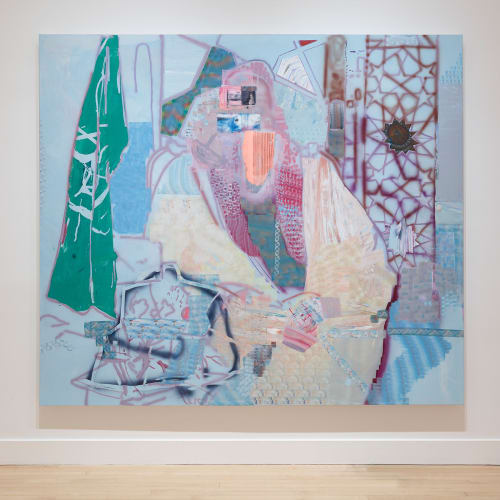Taha Heydari: Running Rabbits
Past exhibition
Overview
Haines Gallery is pleased to present Running Rabbits, a solo exhibition of new and recent works by the Iranian artist Taha Heydari. The exhibition follows Heydari’s first museum solo exhibition at the Southeastern Center for Contemporary Art in June 2017, and features a number of paintings from the show, exhibited here for the first time on the West Coast.
A distinctly post-Internet painter, Heydari adopts the visual style of new media and digital art to explore of the power of imagery in constructing contemporary consciousness. Drawing from online news and historical references to create his work, Heydari manipulates his source images until they resemble corrupted image files, using exacting painterly techniques that approximate pixilation and glitch-like repetitions. Each painting resembles a striking digital tapestry, encoded with layers of fragmentary images, content and associations for viewers to unearth. The exhibition’s title, Running Rabbits, refers to the visual phenomenon of useless data skittering across a radar display screen, which occurs when a radar signal is disrupted by another in close proximity.
The List (2017) depicts victims of Iran Air Flight 655, a passenger aircraft shot down by American missiles in 1988, likely mistaken on radar screens as a hostile enemy fighter craft. All 290 passengers aboard the flight were killed. In his painting, Heydari employs a visual rubric of lining up the victims’ headshots that is universally familiar, yet reduces the complex humanity of those pictured. 40th (2017) refers to the Iranian custom of celebrating the deceased in a gathering forty days after their death by depicting a bouquet of flowers customarily used in funerals. Undulating floral ribbons are veiled by pixels and blurs, creating a striking distance between the origin image and its emotional affect it is meant to produce.
Other works reveal and comment on the stagecraft of politics and power. In The Vendor (2017), Heydari depicts a mufti, a scholar of Islamic law, seated before the flag of Saudi Arabia, which remains clearly legible. The work evokes the nation’s role as the world’s leading exporter of oil, but also suggests the Wahhabist ideology, an often extremist sect of Islam that has become increasingly influential in the Saudi Arabia. Throughout the show, the artist highlights the complex relationships between image and reality — particularly when the subject is twice removed, first by photography, then by paint.
Exhibition Views






